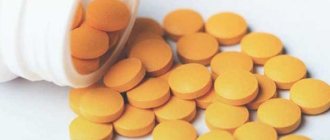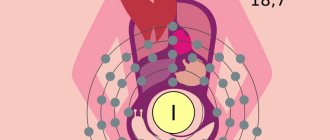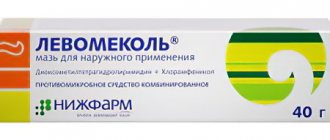Composition and pharmacological action
Theraflu contains phenylephrine hydrochloride, paracetamol, pheniramine maleate (10, 325 and 20 mg each, respectively). The drug is available in two dosage forms: powder and tablets.
The main active ingredients are supplemented with a number of excipients:
- for powder: dyes, sodium citrate, magnesium stearate, sucrose, calcium phosphate, flavors and others;
- for tablets: silicon dioxide, magnesium stearate, povidone, corn-based starch, macrogol and others.
The powder, which requires preliminary dilution in liquid, is packaged in sachets, each of which contains 11.5 g of the active mixture.
To understand how Theraflu works, you need to consider the effect of each of its components on the human body:
- Paracetamol has anti-inflammatory, analgesic, antipyretic effects. This component belongs to the category of NSAIDs; it has the ability to block cyclooxygenase, due to which the conversion of arachidonic acid into prostaglandins does not occur. These substances are derivatives for the appearance of pain and an increase in body temperature above the physiological norm. Once in the human body, paracetamol begins an active effect, reducing inflammation, normalizing body temperature and relieving moderate pain.
- Pheniramine maleate has the ability to block histamine receptors. This allows you to reduce the negative effects of histamine, which leads to a decrease in swelling of the nasal cavity, improved nasal breathing, relief from itching, watery eyes, and redness of the eyes.
- Phenylephrine hydrochloride is a substance that has a pronounced effect on alpha-adrenergic receptors, which leads to a narrowing of arterial vessels. This effect of the drug relieves a person from swelling of the nasal mucosa.
After oral consumption of the powder or Theraflu tablets, the active substances are rapidly absorbed into the systemic bloodstream. After this, the components are evenly distributed in tissues, as well as biological fluids, providing a pronounced therapeutic effect.
The drug is excreted outside the body, after undergoing metabolic processes in the liver, along with urine.
Forms of release of the drug
The drug for respiratory diseases, Theraflu, is available in the form of a free-flowing white granular powder. The drug is taken orally (by mouth). One sachet usually contains the following amount of active ingredients: 650 mg of paracetamol, 20 mg of pheniramine maleate, and 10 mg of phenylephrine hydrochloride.
There are several types of the drug:
- Theraflu Extra Apple-Cinnamon eliminates the main symptoms characteristic of the flu (fever, headache, chills, etc.);
- Theraflu Lar Menthol relieves sore throat;
- Theraflu Bro Ointment treats cough;
- Theraflu for colds helps against symptoms typical of colds and flu;
- Theraflu Immuno restores and supports immunity.
Indications and contraindications
The main indication for the use of Theraflu is the relief of negative symptoms that constantly accompany any viral diseases that affect the respiratory organs. This could be influenza or parainfluenza, various acute respiratory viral infections (adenovirus, rhinovirus, respiratory syncytial infection and other pathologies).
Taking Theraflu allows you to quickly get rid of:
- increased body temperature;
- pain of various localizations (head, joints, muscles);
- facilitate nasal breathing by reducing the amount of mucus discharge;
- relieve redness of the eyes and lacrimation;
- relieve body aches;
- normalize the general condition.
Not all categories of patients are allowed to use the drug; there is a list of conditions (reflected in the instructions) when the use of Theraflu is strictly prohibited.
Contraindications for use:
- liver diseases;
- high sensitivity to any of the components included in the medication;
- chronic alcoholism;
- simultaneous use of drugs related to monoamine oxidase inhibitors, tricyclic antidepressants, beta-blockers;
- increased portal vein pressure;
- diabetes mellitus (types 1, 2);
- children under 12 years of age;
- pregnancy period;
- time of breastfeeding the baby.
In addition to absolute prohibitions on the use of Theraflu, there are relative ones. This means that the drug can be used but only after consulting the patient with the doctor and obtaining his permission for such therapy.
Theraflu should be used with caution if:
- severe atherosclerosis of the coronary arteries;
- increased blood pressure levels;
- deficiency of certain enzymes;
- angle-closure glaucoma;
- increased intraocular pressure;
- pathological conditions of the liver (Rother, Gilbert, Dubin-Johnson syndromes);
- impaired functioning of the kidneys and liver;
- tumor conditions of the adrenal glands (benign type);
- hyperthyroidism;
- prostate gland, enlarged in size.
Pharmacological properties
The combined remedy has antipyretic, anti-inflammatory, progesteroneic, analgesic and antiallergic effects, eliminates the symptoms of “colds”.
The effect of the drug is due to the components included in its composition. Paracetamol has an antipyretic effect by blocking cyclooxygenase mainly in the central nervous system, affecting the centers of pain and thermoregulation. It has virtually no anti-inflammatory effect.
Paracetamol does not affect the synthesis of prostaglandins in peripheral tissues, thus not having a negative effect on water-salt metabolism (Na + and water retention) and the mucous membrane of the gastrointestinal tract.
Phenylephrine is an alpha-adrenergic agonist, constricts blood vessels, eliminates swelling and hyperemia of the mucous membrane of the nasal cavity, nasopharynx and paranasal sinuses, reduces exudative manifestations (runny nose).
Chlorphenamine is an H1-histamine receptor blocker that suppresses the symptoms of allergic rhinitis: sneezing, runny nose, itchy eyes, nose, and throat.
Instructions for use
Having decided to take Theraflu, before taking the drug, you need to carefully read the instructions, familiarize yourself with the treatment rules, and clarify the absence of contraindications that would prohibit taking the medication.
The medicine is effectively used to get rid of cold symptoms according to the following rules:
- Take the tablets with enough water;
- the powder is first diluted with water that has boiled and cooled slightly;
- children over 12 years of age and adult patients can take 1 tablet at a time, drink the contents of 1 sachet;
- You are not allowed to take more than four doses of medication per day, keeping equal time intervals between them;
- To increase the therapeutic effect, you can drink 2 tablets/2 powders at once, but not more than once a day.
Despite the fact that the drug can be purchased at pharmacies without the need to present a medical prescription, if you have any concerns or doubts, you should consult a doctor.
The use of the drug for more than three days in a row is not allowed. If the patient does not experience relief from their current condition within this period of time, they should seek help from a qualified professional.
Is it possible to take Theraflu for prevention? This drug contains components that have only a symptomatic effect on the body. They do not in any way affect the cause of the development of negative symptoms, but only eliminate the unpleasant catarrhal symptoms of ARVI. Therefore, it is not advisable to use Theraflu for preventive purposes.
Dosage
The dosage of paracetamol depends on the age of the patient. Separately from the powder, the compound is used from the age of four, but as part of Theraflu - only from the age of 12. Pharmacists attribute this to additional components that negatively affect the child’s body.
Paracetamol at fever is taken 3 times a day with an interval of 4 hours between doses. This time is enough to partially remove the medication and relieve the burden on the liver and kidneys. Take Theraflu for up to 1 week, but if the symptoms do not subside after three days, then self-treatment should be stopped. Seeing a doctor will be the right decision in this situation, because such signs often indicate a serious infection.
Paracetamol for colds will have an effect on the body 15-20 minutes after administration, and the drug will work at full strength after 1 hour. Sometimes the patient becomes sleepy, sometimes the body becomes agitated, but the fever subsides, the eyes become clearer and the person feels an improvement in his condition.
Rapid improvement in illness
Theraflu for children
Theraflu is a medicine containing several components. Therefore, it is not allowed to use the product in children under 12 years of age.
To get rid of cold symptoms in adolescents over 12 years of age, you need to give no more than four tablets per day to children (the same as for adult patients), or dilute the powder no more than 4 times.
What to replace
If the cause of the allergy lies in paracetamol, then drugs based on ibuprofen or aspirin should be chosen as antipyretics: Nurofen, MIG, Novigan, Effervescent aspirin.
If a reaction occurs to excipients, then paracetamol-based products can be used, but without dyes and preservatives. For example, Coldact Flu Plus and Rinza contain paracetamol and ascorbic acid.
The cheapest and most natural analogue of Theraflu can be prepared independently.
You will need:
- Paracetamol tablet.
- Ascorbic acid powder or large tablet.
- A couple of spoons of sugar.
- Tea.
Crush all ingredients, mix, add hot water. You can replace sugar with honey, ascorbic acid with lemon juice, and add cinnamon. Then the composition will become even more natural.
Use during pregnancy and lactation
During pregnancy and while breastfeeding, the drug is not approved for use. Women expecting the birth of a baby or breastfeeding a newborn should prefer one-component formulations to relieve unpleasant cold symptoms (after consulting with a doctor).
Contraindications for use
Theraflu should not be used in the following cases:
- any stage of pregnancy;
- breastfeeding period;
- the age limit is the patient's age up to four years;
- hypersensitivity to constituent substances.
Adverse reactions during treatment rarely appear, most often as a result of non-compliance with the dosage and duration of use. Undesirable reactions include irritation and swelling of the larynx, rash and redness of the facial skin.
If the drug is used for more than 10 days, there is a high probability of staining the tongue and tooth enamel brown. When the drug is discontinued, the color returns to normal.
If the dosage is exceeded, symptoms of overdose may appear, which manifest themselves in the form of nausea or vomiting.
Side effects
Adults should not drink the powder for more than three days in a row, otherwise the likelihood of developing negative manifestations increases.
Side effects:
- Gastrointestinal organs: pain in the epigastric region, nausea, dryness of the oral mucosa;
- CNS: increased excitability, increased nervousness, sleep disturbances, headaches, problems falling asleep;
- heart and blood vessels: increased blood pressure, heart rhythm disturbances;
- sense organs: increased pressure inside the eyes, constriction of the pupils, development of accommodation paresis;
- circulatory system: the occurrence of anemia, thrombocytopenia, agranulocytosis (all parameters return to normal some time after stopping drug therapy);
- urinary system: decreased volume of urine excreted, a pronounced nephrotoxic effect on the body, increased glucose levels in urine;
- allergic manifestations: the appearance of a rash on the skin, redness accompanied by itching, the development of urticaria, Quincke's edema, anaphylactic shock (this effect develops very rarely, as an individual reaction to the use of the drug).
The occurrence of any negative reactions of the body is a reason to immediately stop drug therapy and consult a doctor for medical help.
When taking Theraflu, you should remember that this medication can have different effects on other drugs used at the same time. When a person takes any medications, before starting to use Theraflu, he should read the instructions in order to assess the possibility or consequences of such a combination.
Drug interactions:
- Theraflu enhances the effects of ethanol, sedatives, and monoamine oxidase inhibitors on the body;
- simultaneous use of barbiturates, Zidovudine, carbamazepine, liver enzyme inducers, Phenytoin, Rifampicin leads to increased hepatoxic effects, which gives paracetamol;
- the use of glucocorticosteroids leads to an increase in pressure inside the eyes;
- the use of Theraflu and uricosuric drugs may reduce the effectiveness of the latter;
- indirect anticoagulants can enhance their own effects on the body;
- the sympathomimetic effect will be increased if the patient simultaneously uses tricyclic antidepressants;
- Halothane increases the risk of ventricular arrhythmia;
- simultaneous use of Theraflu and Guanethidine. may increase the stimulating functions of phenylephrine hydrochloride, while simultaneously reducing the hypotensive effect of the drug;
- The risk of developing side effects, including dry mouth, digestive disorders, and retention of urine from the body, increases when the patient is simultaneously taking antiparkinsonian drugs, antidepressants, phenothiazine derivatives or antipsychotic drugs.
Interaction with other drugs
Concomitant use of Theraflu tablets with barbiturates increases the risk of paracetamol toxicity.
The combination of Theraflu with antipsychotics, antidepressants and phenothiazine derivatives can cause urinary retention, constipation and dry mouth.
Theraflu is not recommended to be taken with glucocorticosteroids
Concomitant use with glucocorticosteroids often increases intraocular pressure. Drugs that help slow gastric emptying, when taken simultaneously with Theraflu tablets, impair its absorption into the bloodstream. Medicines to speed up gastric emptying, on the contrary, speed up the absorption of the drug. Simultaneous use of paracetamol with chloramphenicol slows down the elimination of the latter by 5 times.
It is not recommended to use Theraflu simultaneously with salicylamide; this increases the excretion of paracetamol from the body and increases the risk of its toxic effects. The combination of chlorzoxazone with paracetamol increases their hepatotoxicity. The simultaneous use of Theraflu with zidovudine entails increased neutropenia; the use of paracetamol with coumarin enhances the effect of the latter.
Overdose
Nausea, vomiting, pain in the epigastric region, hepatotoxic and nephrotoxic effects, in severe cases - liver failure, hepatonecrosis, increased activity of “liver” transaminases, increased prothrombin time, encephalopathy and coma.
Treatment:
gastric lavage, taking activated carbon, symptomatic therapy. Administration of methionine 8-9 hours after an overdose and acetylcysteine - after 12 hours. You should seek medical help.











